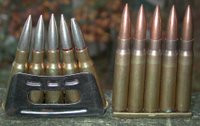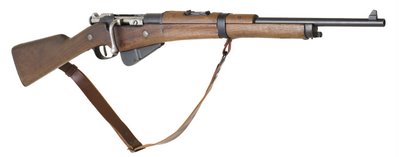In 1890, a carbine designed by Mssr. Berthier, a railroad official in French Algeria, was adopted for use by cavalry and the Gendarmerie. It combined a bolt very similar to the Lebel's with a Mannlicher-type clip-fed magazine. Being saddled with the fat, rimmed 8mm Lebel round prevented the use of a Mauser-style staggered box magazine, and with the cartridges stacked vertically, the new carbine could only accommodate three rounds without (it was thought at the time) making the receiver impractically bulky, but it could be reloaded much faster than any shortened Lebel.

RIGHT: 8mm Lebel rounds are wide and heavily tapered when compared with the more modern 8x57mm Mauser.
The carbine used a turned-down bolt handle, to keep it from snagging on things while the cavalry troops went about their business with their weapons slung. The sights were the same as those on the Lebel; a tangent-type rear sight combined with a coarse front blade that had a thin notch in the middle for fine aiming. Soon, rifle-length versions of the weapon were fielded for France's Indo-Chinese and Senegalese colonial troops.

LEFT: The unusual French front sight blade.
Photo by Oleg Volk
As the Great War ground on, supply of the Lebel rifles could not keep up with demand, and the rifle-length Berthier was modified with a straight, Lebel-esque bolt handle and issued generally as the Mle. 1907/15. Production was expanded: Previously only made at the St. Etienne arsenal, production was now taken up by the Tulle and Chattelerault arsenals, and contracts were let to Continsouza and Delaunay in France and the Remington Arms Company in the USA. In 1916, Berthier rifles and carbines were modified further thanks to battlefield feedback. A sheet-metal extension was added to the magazine, bringing capacity to five rounds, and one of the defects of the Mannlicher system was ameliorated by the addition of a hinged cover over the clip ejection port on the bottom of the magazine, which had been liable to collect dirt when a soldier went prone.
The final carbine variant, the Mousqueton d'Artillerie Mle. 1916 was one of the most popular variants with the troops: light and handy, with a snag-resistant turned-down bolt handle and side-mounted sling swivels, it could be carried comfortably slung across the back without getting in the way; it held five rounds, and although it couldn't be "topped-off" like the Mauser, it could be reloaded just as quickly. It had a wooden handguard atop the barrel for a handhold during bayonet work, unlike the previous Berthiers, and was well-recieved by poilus outside the artillery troops it had been intended for.
The Mle. 1916 is undergoing the same gradual increase in collector interest as other French longarms. Tatty examples can still be found for not much over a C-note, while a really nice specimen may nudge the $400 mark. Ammunition can be difficult to find, and without the stamped sheet metal clips it is, like any other Mannlicher-type weapon, a single shot. One other thing to beware of is that most surplus Lebel ammunition you will encounter is the later "Balle N" round, a hotter loading designed for machineguns. Unless your rifle is marked as converted to accept this cartridge and has passed headspace checks and safety tests by a competent gunsmith, it's best to view it as a wall hanger and not a shooter, at least where surplus ammo is concerned.



11 comments:
came across one of these the other day...
http://www.gunsworld.com/french/mas/m36_gal_us.html
Tam,
I simply love these little history lessons.
Keep 'em coming, please.
I've got 2 Berthier carbines. They're deceptively accurate with good handloads.
Surplus ammo usually won't go bang, but if you can get it for 13 cents a round, it's worth it to pull the bullets and load your own. Brass is available now.
IMHO, the Berthier is a great little brush gun. It's handy and throws a nice heavy bullet.
Great site, BTW.
Had one of the Continsouza's about 15 years ago. Paid 65 bucks for it, didn't even know what the caliber was at the time. Wish I had it now.
I have a 1907-15 remington rifle. It is mint condition... I need the clip that goes to it.... I have had it for years but the clip was lost a long time ago. Can anyone help me find one ? I have it as art on my wall only.... never will fire it....It has a special meaning for me . ty
Collette
I am so dumb and new to this stuff. so diamondback ? were u telling me to go to that web sight and i can find the clip ? man sorry guys. I know I will never get rid of the rifle. And It will hang in my front room with my fathers and grandfathers army pictures, (SOME GOOD, SOME BAD) but I just want the clip to make the rifle complete. I also have a 1942 that was used in war and has the clip in it. I can find no info on it either. They are both in my name.
I have a Remington model of this rifle. It looks like there may have been some modifications to it, but I am not positive. The bottom hole looks like it will only hold the case for the three bullets. Please email boopadoop73@aol.com if you are interested. I will send you all of the informatin I can, but as I am not knowledgeable, I will help answer any questions or send pics.
Venus
i have a 1918 model of one of these with matching serial#s. no clip or shells though.
my mistake i think it is a 1916 model.
My father has one of these that his uncle brought back from WWI. I got interested in it a couple of years ago, and this site was very informative. Thank you, Tamara.
Now for the really good news: Serbian ammunition manufacturer PRVI Partisan makes the 8x50mmR Lebel ammo today, and you can purchase it from Midway USA online. Make sure you get the 8x50mmR (R for rimmed) and not the 8mm Lebel pistol ammo.
The early 3, and later 5 bullet clips are readily available from a number of vendors. I bought mine from an antique firearms guy on GunBroker.com. You can also contact CL Cogar in Corinth Maine [libertytreecollectors@yahoo.com]
We took it to the range for its first exercise in over 60 years, and it was a real pleasure to shoot.
Enjoy!
ML
I just got one for 80 bucks at a farm auction. Its a 1916 5 round Continsouza N. Stock an barrel maching except trigger gaurd an bolt. But a comment on Remington built Berthiers, they are unsafe to use. If they look brand new an dont have a serial number there is a reason for it. The French rejected them cause they were dangerouse to use cause of improper manufacturing. Id have them checked out by a gunsmith before useing one made by Remington. (nothing against Remington)
Post a Comment